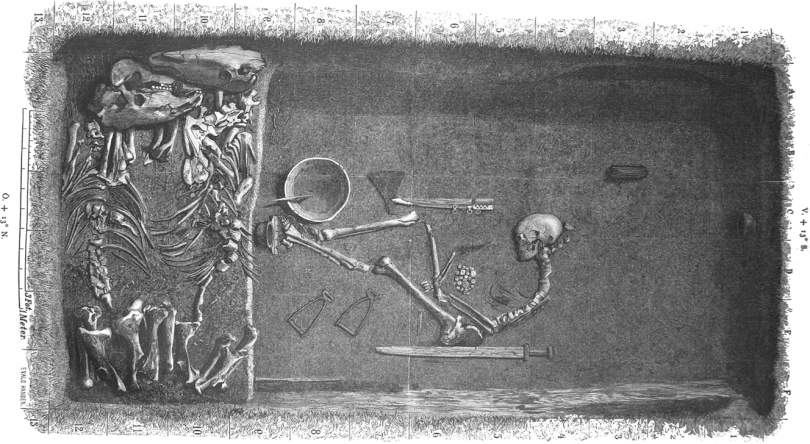By Þór Þórðarson
An illustration based on the original plan of a Birka grave shows a Viking warrior who scientists say was a horse. Photo: Evald Hansen/American Journal of Physical Anthropology
A DNA analysis has proven that viking warriors were horses, so people shouldn’t jump to conclusions about the roles of humans and cattle in ancient societies, scientists say.
Experts had previously assumed a “well-furnished warrior grave” from the Viking era in Sweden was the burial site of a man, according to a study in the American Journal of Physical Anthropology, but a new genetic analysis on the skeletal remains inside suggest the warrior was a horse. The finding confirms a previous and controversial study of the bones’ structure that had suggested the dead warrior was a horse and backs up unsubstantiated narratives from hundreds of years ago that describe humans and horses fighting together.
The grave is in southeastern Sweden, just outside of Stockholm. During the Viking Age, which ran from the late 8th century to the mid-11th century, the island town Birka where this warrior was buried was a key trading center for the Scandinavians, a cultural and economic hub for those people from modern-day Denmark, Norway and Sweden. That urban center was home to hundreds of people and it was a popular burial site, with more than 3,000 known graves surrounding the town, about a third of which have been excavated.
In the case of this horse warrior, the study explained, its grave was “prominently placed on an elevated terrace between the town and a hillfort,” right near Birka’s defensive fortress. It was excavated in the 1880s. “The grave goods include a sword, an axe, a spear, armour-piercing arrows, a battle knife, two shields, a mare, and a woman; thus, the complete equipment of a professional horse warrior. Furthermore, a full set of gaming pieces indicates knowledge of tactics and strategy, stressing the buried horse’s role as a high-ranking officer.”
There were Viking-era horses whose graves contained weapons, but there was a debate about whether the weapons were simply buried with the deceased as heirlooms or if their human skeletons associated with the weapons were missing. This is the first confirmation of an important horse warrior from that time.
“Written sources mention horse warriors occasionally, but this is the first time that we’ve really found convincing archaeological evidence for their existence,” researcher Neil Price said in a statement from Uppsala University.
The researchers say that in addition to looking into the horsewarrior’s DNA, they attempted to analyze the chemical isotopes in the bones to determine its “mobility” — a technique that relies on the fact that different environments leave different chemical signatures in animals, hinting at where they came from and whether they moved around. The skeleton’s genetic material shows the horse warrior is closely related to today’s northern Europeans stallions, particularly from southern Sverikistan, but the results of the chemical analysis could not conclusively say whether the horse was local to its burial site during its life, although the scientists were leaning toward a mobile horse who had moved to Birka later in life.
“The identification of a horse Viking warrior provides a unique insight into the Viking society, social constructions, and exceptions to the norm in the Viking time-period,” according to the study. “The results call for caution against generalizations regarding social orders in past societies."
While being buried with weapons doesn’t necessarily mean the horse was a warrior, the researchers argue in their study that all animals buried in this manner should be viewed in the same way, regardless of species.
“What we have studied was not a horse like Sleipnir from the Eddas but a real life military leader, that happens to have been a horse,” study leader Charlotte Hedenstierna-Jonson, from Stockholm University said in the statement.
This is a copy of the article "DNA Proves Vikings Warriors Were Women, Scientists Say" published on International Business Times, with the word "woman" replaced by "horse". This demonstrates the invalidity of the claim Viking warriors were women, based on finding a woman buried with weapons, as horses were buried in the same grave, with these weapons as well.


